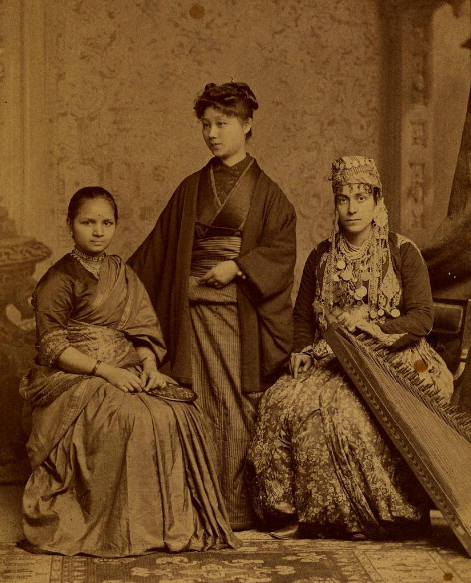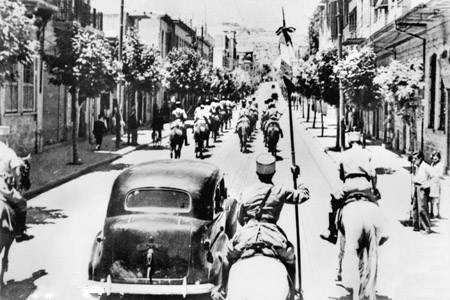|
Kobani
Kobani, also Kobane, officially Ayn al-Arab, is a Kurdish-majority city in the Ayn al-Arab District in northern Syria, lying immediately south of the Syria–Turkey border. As a consequence of the Syrian civil war, the city came under the control of the Kurdish-majority People's Protection Units (YPG) militia in 2012 and became the administrative center of the Kobani Canton, later transformed into Euphrates Region of the Autonomous Administration of North and East Syria. From September 2014 to January 2015, the city was under siege by the Islamic State of Iraq and the Levant. Most of the eastern parts of the city were destroyed and most of the population fled to Turkey. In 2015, many returned and reconstruction began. In mid October 2019, Kurdish forces accepted the entry of the Syrian Army and Russian Military Police in a bid to stop Turkey from invading the town. Prior to the Syrian Civil War, Kobani was recorded as having a population of close to 45,000. According to 2 ... [...More Info...] [...Related Items...] OR: [Wikipedia] [Google] [Baidu] |
Siege Of Kobanî
The siege of Kobanî was launched by the Islamic State (IS) on 13 September 2014, in order to capture the Kobanî Canton and its main city of Kobanî (also known as Kobanê or Ayn al-Arab) in northern Syria, in the ''de facto'' autonomous region of Rojava. By 2 October 2014, IS succeeded in capturing 350 Kurdish villages and towns in the vicinity of Kobanê, generating a wave of some 300,000 Kurdish refugees, who fled across the border into Turkey's Şanlıurfa Province. By January 2015, the number had risen to 400,000. The Kurdish People's Protection Units (YPG) and some Free Syrian Army (FSA) factions (under the Euphrates Volcano joint operations room), Peshmerga of the Kurdistan Regional Government, and American and US-allied Arab militaries' airstrikes began to recapture Kobane. On 26 January 2015, the YPG and its allies, backed by the continued US-led airstrikes, began to retake the city, driving IS into a steady retreat. The city of Kobanê was fully recaptured on 2 ... [...More Info...] [...Related Items...] OR: [Wikipedia] [Google] [Baidu] |
Autonomous Administration Of North And East Syria
The Democratic Autonomous Administration of North and East Syria (DAANES), also known as Rojava, is a ''de facto'' Autonomous administrative division, autonomous region in northeastern Syria. It consists of self-governing Regions of North and East Syria, sub-regions in the areas of Jazira Region, Jazira, Euphrates Region, Euphrates, Raqqa, Al-Thawrah, Tabqa, and Deir ez-Zor Governorate, Deir ez-Zor. The region gained its ''de facto'' autonomy in 2012 in the context of the ongoing Rojava conflict and the wider Syrian civil war, in which its official military force, the Syrian Democratic Forces (SDF), has taken part. While entertaining Foreign relations of Rojava, some foreign relations, the region is neither officially recognized as autonomous by the government of Syria, state, or other governments institutions except for the Parliament of Catalonia, Catalan Parliament. Northeastern Syria is Polyethnicity, polyethnic and home to sizeable ethnic Arab, Kurds, Kurdish, and Assyrian ... [...More Info...] [...Related Items...] OR: [Wikipedia] [Google] [Baidu] |
Euphrates Region
Euphrates Region, formerly Kobanî Canton, (; ; ) is the central of three original regions of the Autonomous Administration of North and East Syria, comprising Ayn al-Arab District of the Aleppo Governorate, Tell Abyad District of the Raqqa Governorate, and the westernmost tip of the Ras al-Ayn Subdistrict of the Ras al-Ayn District of Al-Hasakah Governorate. Euphrates Region unilaterally declared autonomy in January 2014 and since ''de facto'' is under direct democratic government in line with the polyethnic Constitution of Rojava. The region has two subordinate cantons, the Kobani Canton consisting of the Sarrin area (with the al-Jalabiya district subordinate to it) and the Kobani area (with the Şêran and the Qenaya Subdistricts subordinate to it), as well as the Tel Abyad Canton (with the Ain Issa and Suluk Subdistricts subordinate to it). Demographics The current population of Euphrates Region is unknown due to substantial refugee movements, but that of Kobane ... [...More Info...] [...Related Items...] OR: [Wikipedia] [Google] [Baidu] |
Ayn Al-Arab Subdistrict
{{AleppoSY-geo-stub ...
Ayn al-Arab Subdistrict () is a subdistrict of Ayn al-Arab District in northeastern Aleppo Governorate, northern Syria. The administrative centre is the city of Kobani. At the 2004 census, the subdistrict had a population of 81,424. Cities, towns and villages References Ayn al-Arab District Ayn al-Arab Kobani, also Kobane, officially Ayn al-Arab, is a Kurdish-majority city in the Ayn al-Arab District in northern Syria, lying immediately south of the Syria–Turkey border. As a consequence of the Syrian civil war, the city came under the co ... [...More Info...] [...Related Items...] OR: [Wikipedia] [Google] [Baidu] |
Ayn Al-Arab District
`Ain al-`Arab District () is a district of Aleppo Governorate in northern Syria. The administrative centre is the city of Kobani. The district fills the northeastern section of the governorate, and its northern boundary is along the Syria–Turkey border The border between the Syrian Arab Republic and the Republic of Turkey (; ) is long, and runs from the Mediterranean Sea in the west to the tripoint with Iraq in the east. It runs across Upper Mesopotamia for some , crossing the Euphrates and .... At the 2004 census, the district had a population of 192,513. Sub-districts The district of Ayn Al-Arab is divided into four sub-districts or nawāḥī (''population as of 2004''): Al-Jalabiyah Subdistrict was separated from Sarrin Subdistrict in 2009. References Districts of Aleppo Governorate {{AleppoSY-geo-stub ... [...More Info...] [...Related Items...] OR: [Wikipedia] [Google] [Baidu] |
People's Protection Units
The People's Defense Units (YPG), also called People's Protection Units, is a libertarian socialist US-backed Kurds in Syria, Kurdish militant group in Syria and the primary component of the Syrian Democratic Forces (SDF). The YPG mostly consists of Kurds, but also includes Arabs and YPG International, foreign volunteers; it is closely allied to the Syriac Military Council, an Assyrian people, Assyrian militia. The YPG was formed in 2011. It expanded rapidly in the Syrian Civil War and came to predominate over other armed Syrian Kurdish groups. A sister militia, the Women's Protection Units (YPJ), fights alongside them. The YPG is active in the Autonomous Administration of North and East Syria (Rojava), particularly in Syrian Kurdistan, its Kurdish regions. In early 2015, the group won a major victory over the Islamic State (IS) during the siege of Kobanî, where the YPG began to receive air and ground support from the United States and other Combined Joint Task Force � ... [...More Info...] [...Related Items...] OR: [Wikipedia] [Google] [Baidu] |
Syria
Syria, officially the Syrian Arab Republic, is a country in West Asia located in the Eastern Mediterranean and the Levant. It borders the Mediterranean Sea to the west, Turkey to Syria–Turkey border, the north, Iraq to Iraq–Syria border, the east and southeast, Jordan to Jordan–Syria border, the south, and Israel and Lebanon to Lebanon–Syria border, the southwest. It is a republic under Syrian transitional government, a transitional government and comprises Governorates of Syria, 14 governorates. Damascus is the capital and largest city. With a population of 25 million across an area of , it is the List of countries and dependencies by population, 57th-most populous and List of countries and dependencies by area, 87th-largest country. The name "Syria" historically referred to a Syria (region), wider region. The modern state encompasses the sites of several ancient kingdoms and empires, including the Eblan civilization. Damascus was the seat of the Umayyad Caliphate and ... [...More Info...] [...Related Items...] OR: [Wikipedia] [Google] [Baidu] |
Kurds In Syria
The Kurdish population of Syria is the country's largest ethnic minority, usually estimated at around 10% of the Syrian population Kurds are the largest ethnic minority in Syria, constituting around 10 per cent of the population – around 2 million of the pre-conflict population of around 22 million. In this atlas, French geographer Balanche suggests that "As of 2010, Syria’s population was roughly 65% Sunni Arab, 15% Kurdish, 10% Alawite, 5% Christian, 3% Druze, 1% Ismaili, and 1% Twelver Shia." (p. 13) "The number of Kurds in Syria is often underestimated by analysts, who tend to cap them at 10% of the population. In fact, they are closer to 15%."(p. 16) The 2018 breakdown is 1% Sunni Arab, 16% Kurdish, 13% Alawite, 3% Christian, 4% Druze, 1% Ismaili, 1% Twelver Shia, 1% Turkmen (p. 22) Balanche also refers to his ''Atlas du ProcheOrient Arabe'' (Paris: Presses de l’Université Paris-Sorbonne, 2011), p. 36." and 5% of the Kurdish population. The majority of Syrian ... [...More Info...] [...Related Items...] OR: [Wikipedia] [Google] [Baidu] |
Nahiyah
A nāḥiyah ( , plural ''nawāḥī'' ), also nahiyeh, nahiya or nahia, is a regional or local type of administrative division that usually consists of a number of villages or sometimes smaller towns. In Tajikistan, it is a second-level division while in Syria, Iraq, Lebanon, Jordan, Xinjiang, and the former administrative divisions of the Ottoman Empire, Ottoman Empire, where it was also called a ''bucak (administrative unit), bucak'', it is a third-level or lower division. It can constitute a division of a ''qadaa'', ''mintaqah'' or other such district-type division and is sometimes translated as "subdistrict". Ottoman Empire The nahiye () was an administrative territorial entity of the Ottoman Empire, smaller than a . The head was a (governor) who was appointed by the Pasha. The was a subdivision of a Selçuk Akşin Somel. "Kazâ". ''The A to Z of the Ottoman Empire''. Volume 152 of A to Z Guides. Rowman & Littlefield, 2010. p. 151. and corresponded roughly to a city w ... [...More Info...] [...Related Items...] OR: [Wikipedia] [Google] [Baidu] |
Syrian Army
The Syrian Army is the land force branch of the Syrian Armed Forces. Up until the fall of the Assad regime, the Syrian Arab Army existed as a land force branch of the Syrian Arab Armed Forces, which dominanted the military service of the four uniformed services, controlling the most senior posts in the armed forces, and had the greatest manpower, approximately 80 percent of the combined services.. The Syrian Army originated in local military forces formed by the French after World War I, after France obtained a mandate over the region. It officially came into being in 1945, before Syria obtained full independence the following year and 2 years after official independance. After 1946, it played a major role in Syria's governance, mounting six military coups: two in 1949, including the March 1949 Syrian coup d'état and the August 1949 coup by Colonel Sami al-Hinnawi, and one each in 1951, 1954, 1963, 1966, and 1970. It fought four wars with Israel (1948, the Six-Day War in ... [...More Info...] [...Related Items...] OR: [Wikipedia] [Google] [Baidu] |
Baghdad Railway
Baghdad ( or ; , ) is the capital and List of largest cities of Iraq, largest city of Iraq, located along the Tigris in the central part of the country. With a population exceeding 7 million, it ranks among the List of largest cities in the Arab world, most populous cities in the Middle East and Arab world and forms 22% of the Demographics of Iraq, country's population. Spanning an area of approximately , Baghdad is the capital of its Baghdad Governorate, governorate and serves as Iraq's political, economic, and cultural hub. Founded in 762 AD by Al-Mansur, Baghdad was the capital of the Abbasid Caliphate and became its most notable development project. The city evolved into a cultural and intellectual center of the Muslim world. This, in addition to housing several key academic institutions, including the House of Wisdom, as well as a multi-ethnic and multi-religious environment, garnered it a worldwide reputation as the "Center of Learning". For much of the Abbasid era, duri ... [...More Info...] [...Related Items...] OR: [Wikipedia] [Google] [Baidu] |





